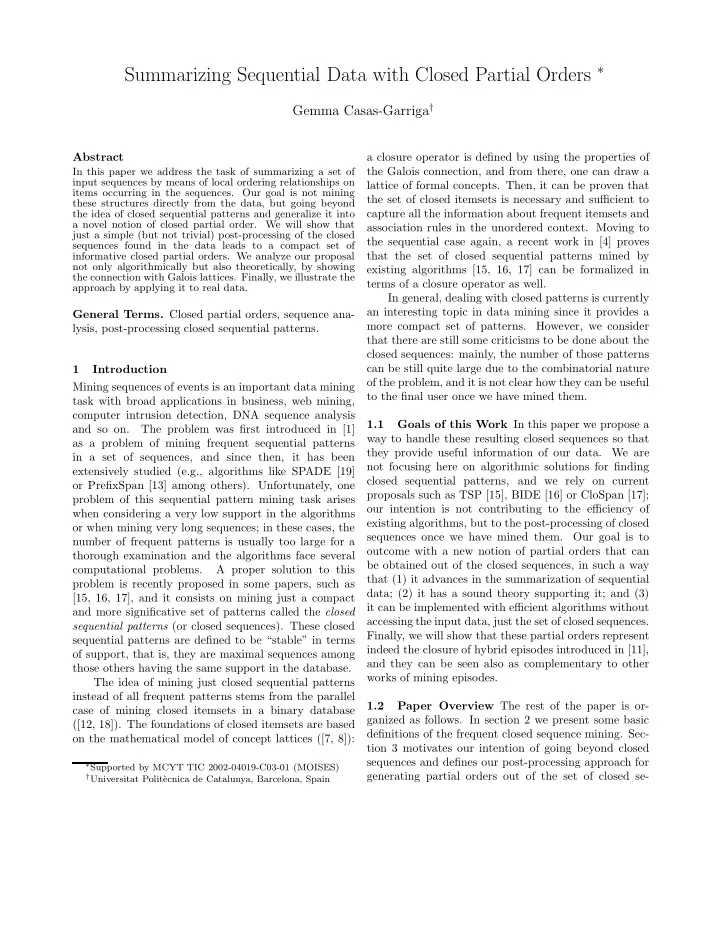

Summarizing Sequential Data with Closed Partial Orders ∗ Gemma Casas-Garriga † Abstract a closure operator is defined by using the properties of In this paper we address the task of summarizing a set of the Galois connection, and from there, one can draw a input sequences by means of local ordering relationships on lattice of formal concepts. Then, it can be proven that items occurring in the sequences. Our goal is not mining the set of closed itemsets is necessary and sufficient to these structures directly from the data, but going beyond the idea of closed sequential patterns and generalize it into capture all the information about frequent itemsets and a novel notion of closed partial order. We will show that association rules in the unordered context. Moving to just a simple (but not trivial) post-processing of the closed the sequential case again, a recent work in [4] proves sequences found in the data leads to a compact set of informative closed partial orders. We analyze our proposal that the set of closed sequential patterns mined by not only algorithmically but also theoretically, by showing existing algorithms [15, 16, 17] can be formalized in the connection with Galois lattices. Finally, we illustrate the terms of a closure operator as well. approach by applying it to real data. In general, dealing with closed patterns is currently an interesting topic in data mining since it provides a General Terms. Closed partial orders, sequence ana- more compact set of patterns. However, we consider lysis, post-processing closed sequential patterns. that there are still some criticisms to be done about the closed sequences: mainly, the number of those patterns can be still quite large due to the combinatorial nature 1 Introduction of the problem, and it is not clear how they can be useful Mining sequences of events is an important data mining to the final user once we have mined them. task with broad applications in business, web mining, computer intrusion detection, DNA sequence analysis 1.1 Goals of this Work In this paper we propose a and so on. The problem was first introduced in [1] way to handle these resulting closed sequences so that as a problem of mining frequent sequential patterns they provide useful information of our data. We are in a set of sequences, and since then, it has been not focusing here on algorithmic solutions for finding extensively studied (e.g., algorithms like SPADE [19] closed sequential patterns, and we rely on current or PrefixSpan [13] among others). Unfortunately, one proposals such as TSP [15], BIDE [16] or CloSpan [17]; problem of this sequential pattern mining task arises our intention is not contributing to the efficiency of when considering a very low support in the algorithms existing algorithms, but to the post-processing of closed or when mining very long sequences; in these cases, the sequences once we have mined them. Our goal is to number of frequent patterns is usually too large for a outcome with a new notion of partial orders that can thorough examination and the algorithms face several be obtained out of the closed sequences, in such a way computational problems. A proper solution to this that (1) it advances in the summarization of sequential problem is recently proposed in some papers, such as data; (2) it has a sound theory supporting it; and (3) [15, 16, 17], and it consists on mining just a compact it can be implemented with efficient algorithms without and more significative set of patterns called the closed accessing the input data, just the set of closed sequences. sequential patterns (or closed sequences). These closed Finally, we will show that these partial orders represent sequential patterns are defined to be “stable” in terms indeed the closure of hybrid episodes introduced in [11], of support, that is, they are maximal sequences among and they can be seen also as complementary to other those others having the same support in the database. works of mining episodes. The idea of mining just closed sequential patterns instead of all frequent patterns stems from the parallel Paper Overview The rest of the paper is or- 1.2 case of mining closed itemsets in a binary database ganized as follows. In section 2 we present some basic ([12, 18]). The foundations of closed itemsets are based definitions of the frequent closed sequence mining. Sec- on the mathematical model of concept lattices ([7, 8]): tion 3 motivates our intention of going beyond closed sequences and defines our post-processing approach for ∗ Supported by MCYT TIC 2002-04019-C03-01 (MOISES) generating partial orders out of the set of closed se- † Universitat Polit` ecnica de Catalunya, Barcelona, Spain
Recommend
More recommend